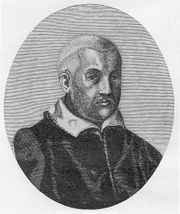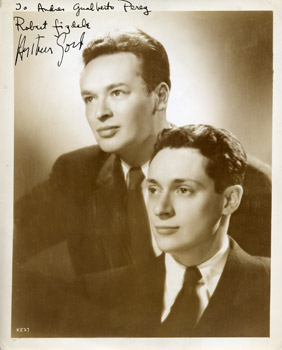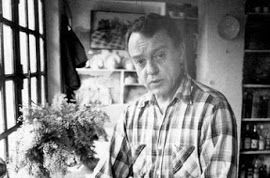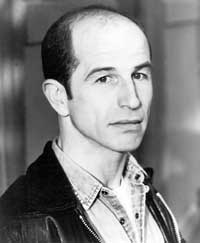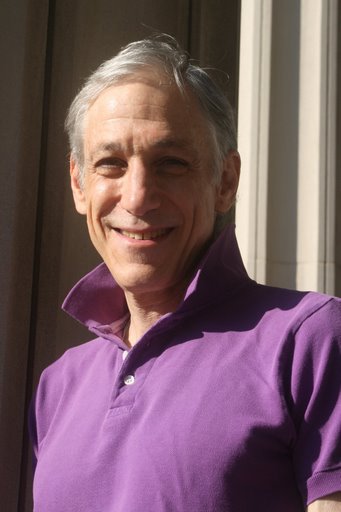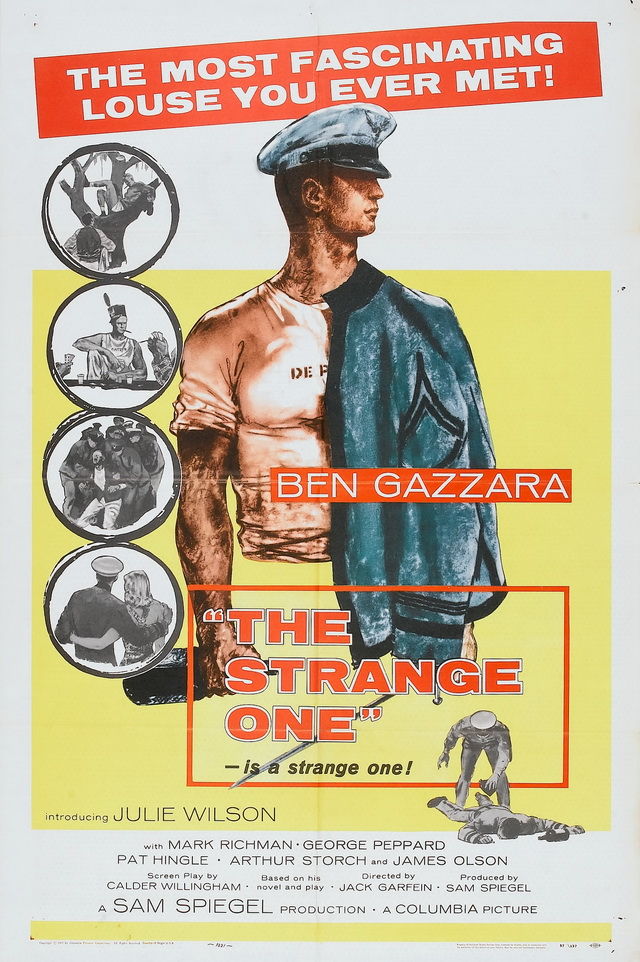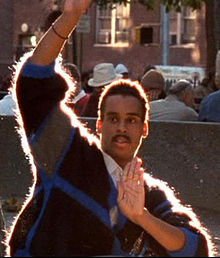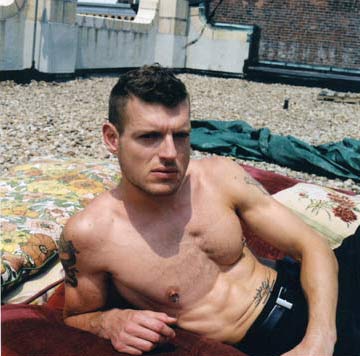|
presents THIS DAY IN GAY HISTORY based on: The White Crane Institute's 'Gay Wisdom', Gay Birthdays, Gay For Today, Famous GLBT, glbt-Gay Encylopedia, Today in Gay History, Wikipedia, and more …
Collected by Ted April 12 [{(o)}]|[{(o)}]|[{(o)}]|[{(o)}]| [{(o)}]|[{(o)}]
1526 – Marc-Antoine Muret, French humanist and philosopher, born (d.1586); Known as Muretus, he was a French humanist who was among the revivers of a Ciceronian Latin style and is among the usual candidates for the best Latin prose stylist of the Renaissance. It wasn't exactly easy to be a humanist in the 16th century. The slightest misstep and you'd end up seeing your entrails popping right before your very eyes as you burned at the stake. In France, in particular, the Church had a couple of effective ways to dispatch those whose views were too liberal - charge them with sodomy or Protestantism, much the same abnormality to the official medieval mind. Muret was regularly charged with both offenses. Only one of them was true - he was homosexual. His success made him many enemies, and he was thrown into prison on a charge of homosexuality, but released by the intervention of powerful friends. The same accusation was brought against him at Toulouse, and he only saved his life by timely flight. The records of the town show that he was burned in effigy as a Huguenot and as sodomite (1554). After a wandering and insecure life of some years in Italy, he received and accepted the invitation of the Cardinal Ippolito II d'Este to settle in Rome in 1559. In 1561 Muret revisited France as a member of the cardinal's suite at the conference between Roman Catholics and Protestants held at Poissy.
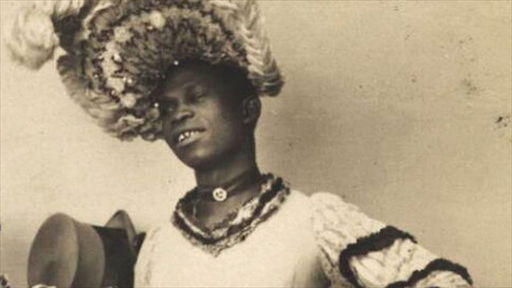
1888 – William Dorsey Swann was arrested for female impersonation. William Dorsey Swann (c.1858 – 1925) was an American gay liberation activist. Born into slavery, he was the first person in the United States to lead a queer resistance group and the first known person to self-identify as a "queen of drag". Swann was born into slavery. He was the fifth oldest child in a family with 13 children. He was enslaved in Hancock, Maryland and was freed by Union soldiers after the Emancipation Proclamation went into effect on January 1, 1863. After the Civil War, his parents were able to buy a farm. Swann's first job was as a hotel waiter. During the 1880s and 1890s, Swann organized a series of balls in Washington, D.C. He called himself the "queen of drag". Most of the attendees of Swann's gatherings were men who were formerly enslaved, and were gathering to dance in their satin and silk dresses. Because these events were secretive, invitations were often quietly made at places like the YMCA. Swann was arrested in police raids numerous times, including in the first documented case of arrests for female impersonation in the United States, on April 12, 1888. In 1896, he was falsely convicted and sentenced to 10 months in jail for "keeping a disorderly house", i.e., running a brothel. After his sentencing, he requested a pardon from President Grover Cleveland. This request was denied, but Swann was the first American on record who pursued legal and political action to defend the LGBTQ community's right to gather. Swann was known to have been close with Pierce Lafayette and Felix Hall, two men who had also both been enslaved and who formed the earliest documented male same-sex relationship between enslaved Americans. When Swann stopped organizing and participating in drag events, his brother continued to make costumes for the drag community. Two of his brothers had been active participants in Swann's drag balls. Swann died in 1925 in Hancock, Maryland. After his death, local officials burned his home.
1889 – Ohio amends its sodomy law to include fellatio. A member of the state legislature tries unsuccessfully to block the bill's passage.
1920 – Robert Fizdale (d.1995) with his partner Arthur Gold (see) were an American two-piano ensemble; they were also authors and television cooking show hosts. 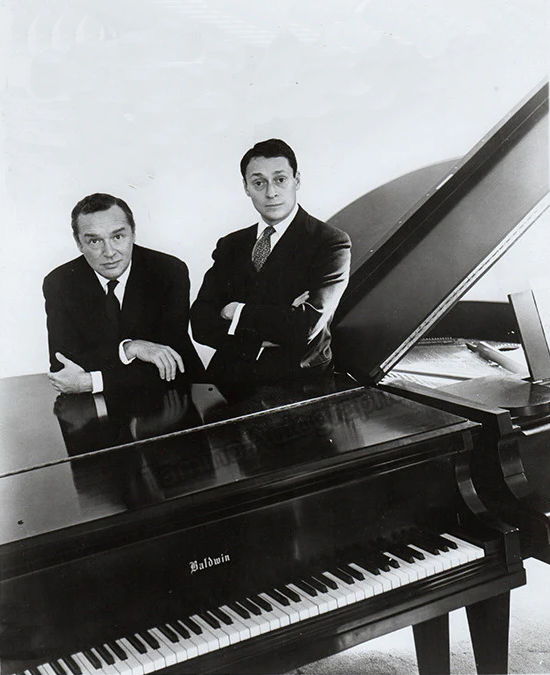 Gold (L) and Fizdale (Click for larger) Gold and Fizdale met during their student years at the Juilliard School. They formed a lifelong gay partnership based around their common interests of music , travel and cooking. Bobby Fizdale was born Robert Fish, the son of John and Rose Fish of Chicago. Both Gold and Fizdale were of Russian Jewish descent. In the late 1970s, Arthur Gold began to have problems with his hands which made it difficult for him to perform, so the duo began to write biographical works, including "Misia: the Life of Misia Sert" (Knopf; and "The Divine Sarah: a Biography of Sarah Bernhardt". The duo also began writing food articles for Vogue magazine and began a television cooking show. In 1984 they published "The Gold and Fizdale Cookbook", which is dedicated to their friend George Balanchine, "In whose kitchen we spent many happy hours..." In 1996, after the death of Fizdale, his estate donated the personal papers, recordings and other memorabilia to the Juilliard School, where they are kept in the school's Peter Jay Sharp Special Collections Room in the Juilliard Library Gold and Fizdale are buried alongside each other at Oakland Cemetery in Sag Harbor, New York.
1921 – Minnesota amends its sodomy law to include oral sex.
1927 – Richard Olney (d.1999) was an American painter, cook, food writer, editor, and memoirist. He was best known for his books of French country cooking. Olney was born in Marathon, Iowa. He lived in a house above the village of Solliès-Toucas in Provence, France, for most of his adult life, where he wrote many classic and influential cookbooks of French country cooking. He had first moved to France in 1951, to Paris, where he was close friends with (and painted many of) the American and English bohemian expatriate set, including James Baldwin, filmmaker Kenneth Anger, painter John Craxton, poet John Ashbery and composer Ned Rorem. Chef Jeremiah Towers was a lover. His deep knowledge of traditional classic French food and wine got him a job writing a column entitled Un Américain (gourmand) à Paris for the journal Cuisine et Vins de France beginning in 1962. After The French Menu Cookbook was published in English in 1970, his then-revolutionary approach of seasonal menus and close attention to wine pairings began to attract notice in Britain and America. By the time he wrote Simple French Food in 1974, he was one of the most important food writers of the era, with a huge impact on nouvelle and California cuisine. James Beard was an important American mentor, and Olney, in the midst of his career, taught a series of cooking classes in Beard's West Village apartment. Despite this, Olney, in a memoir, presents a mixed picture of Beard's character. From 1977 to 1982, Olney edited the 28-volume Time-Life book series The Good Cook. By the time of his death, from heart failure, in addition to the Time-Life set he had written many of his own brilliant, idiosyncratic, poetic books about food and wine. His last book, Reflexions, a memoir, was published posthumously by Brick Tower Press. Olney died aged 72 in Sollies-Toucas, France.
New York City native Hoffman's earliest works either were mounted in small, experimental off-off-Broadway theatres or remained unproduced. It was not until 1985 that he achieved critical acclaim and public recognition when As Is, one of the first plays to focus on the AIDS epidemic, opened in New York City at the Lyceum Theatre, where it ran for 285 performances. Hoffman won a Drama Desk Award for Outstanding New Play and a Tony Award nomination for Best Play. The following year, he adapted the work for a television production directed by Michael Lindsay-Hogg. As an editor at Hill and Wang, Hoffman promoted the careers of Lanford Wilson, Tom Eyen, and Joe Orton, among others, by including their plays in either his New American Plays series or his anthology, Gay Plays: A First Collection. Until the time of his death in 2017, Hoffman was an associate professor of theatre at Lehman College at the City University of New York.
1943 – Charles Ludlam (d.1987) was an American actor, director, and playwright. Ludlam was born in Floral Park, New York,and was raised in Greenlawn, New York. In high school, he fact that he was gay was not a secret. He performed locally in plays with the Township Theater Group, Huntington's community theater, and worked backstage at the Red Barn Theater, a summer stock company in Northport. While he was in his senior year of high school, he directed, produced and performed with a group of friends, students from Huntington, Northport, Greenlawn, and Centerport. Their "Students Repertory Theatre" in the loft studio beneath the Posey School of Dance on Northport's Main Street was large enough to seat an audience of 25; their audiences were appreciative and enthusiastic, and the house was sold out for every performance. Ludlam joined John Vaccaro's Play-House of the Ridiculous, and after a falling out, became founder of the Ridiculous Theatrical Company in New York City in 1967. Ludlam usually appeared in his plays (particularly noted for his female roles), and wrote one of the first plays to deal (though tangentially) with HIV infection. His most popular play, and the only one to enter the standard repertory, is The Mystery of Irma Vep, in which two actors manage, through a variety of quick-change techniques, to play seven roles in a send-up of gothic horror novels. The original production featuring Ludlam and his lover Everett Quinton was a tour de force. In order to ensure cross-dressing, rights to perform the play include a stipulation that the actors must be of the same sex. In 1991, Irma Vep was the most produced play in the United States; and in 2003, it became the longest-running play ever produced in Brazil. Ludlam was diagnosed with AIDS in March 1987. He attempted to fight the disease by putting his lifelong interest in health foods and macrobiotic diet to use. He died a month later of PCP pneumonia in St. Vincent's Hospital, New York. The street in front of his theatre in Sheridan Square was renamed "Charles Ludlam Lane" in his honor.
1945 – The American composer and musician Tom Wilson Weinberg, was born on this date. Tom Wilson Weinberg began singing original queer- themed songs in coffee-houses and gay pride events in the late seventies. A songwriter and singer who has written words and music for the Off- Broadway shows Ten Percent Revue and Get Used To It!, two solo albums, Gay Name Game and All-American Boy, and the Stonewall 25 CD, Don't Mess With Mary. His songs have appeared on several recordings by other artists, including the soundtrack of Beavis and Butt-Head Do America; Feeding the Flame, an AIDS benefit compilation; Ron Romanovsky's Hopeful Romantic and Twin Cities Gay Men's Chorus CD, SING OUT. Gay Name Game (1979) and All-American Boy (1982) were among the first Gay-themed albums. Both were released by Aboveground Records under the name Tom Wilson. In 1982 he assumed the family name Weinberg. Ten Percent Revue opened in Boston in 1985 and played four summers in Provincetown, produced by Laura Green, who took the show to New York in 1988. On tour the show earned two Los Angeles Drama-Logue Awards, three Golden Gull Awards (Provincetown), and the Bessie Smith Award (Boston). For more about his wonderful music visit www.tomwilsonweinberg.com Weinberg’s song "Lesbian Seagull" was featured in the film "Beavis and Butt-head Do America" (Paramount/MTV), on the soundtrack (Geffen/Universal), published by Warner Chappell and released as a single with Red Hot Chili Peppers' "Love Rollercoaster." Tom was a founder of Giovanni's Room and president of The Attic Youth Center, both in Philadelphia. He is a member of ASCAP, OutMusic and The Purple Circuit. He lives with John Whyte, his husband of over 40 years. Tom and John are the dads of boys Jesse and Max.
1953 – Sixty-three men are arrested in Waco, Texas at a "homosexual convention." Tommy Gene Brown, the Waco Bride, was leading a mock wedding when police raided the two-room private residence in South Waco.
1957 – On this date the film The Strange One was released. The Strange One (1957), a psychological drama about military school mores and veiled homosexuality, was promoted as the first picture shot entirely by a cast and crew from New York's the Actors Studio, and the connection shows. Both the power and self-indulgence of that particular school of performing is on ample display here. However, even though some scenes were eventually censored or made less explicit by the Motion Picture Production Code, The Strange One was still a shocking film for its time, and was a harbinger of greater things to come for several of its cast members. Ben Gazzara plays Jocko De Paris, a macho troublemaker who lords over his younger classmates at a southern military school. De Paris and his dim-witted partners in abuse, Koble (Pat Hingle) and Gatt (James Olson), take special joy in tormenting Simmons (Arthur Storch), a young man who appears to be Gay. Maj. Avery (Larry Gates) is an adult who's on to Jocko's power trip, and attempts to get him kicked out of the school. Jocko, on the other hand, recognizes his enemy, and tries to harm Avery's reputation. Gazzara's character is so wholly despicable that the tag line on The Strange One's movie poster actually states: "The Most Fascinating Louse You Ever Met!" He might also be fighting his own homosexual tendencies, but that wasn't the kind of thing you shouted about on movie posters in 1957. Producer Sam Spiegel, who was deep in preparation for David Lean's The Bridge on the River Kwai (1957) and had already produced Elia Kazan's On the Waterfront (1954), originally wanted Kazan to adapt Calder Willingham's play, End as a Man, into a high profile film starring James Dean. When that proposal went nowhere, he decided to position the picture as a low-budget launching pad for several Actors Studio members who had originated their roles on stage. Spiegel then hired Jack Garfein, who had introduced the play to the actors during a Studio workshop, to direct the picture. As generous as this seemed at the time, things quickly headed south once filming began. Initially, Garfein had a close relationship with Spiegel, but he eventually grew to dislike the producer intensely. For starters, Spiegel had problems with the play's powerful, open-ended final act, and he also felt that Willingham was a long- winded bore. To get a small amount of revenge on Spiegel for his needless antagonism, Willingham would actually steal expensive cigars from the producer's desk when he wasn't looking; he'd open his jacket and show them to Garfein after their meetings. Tack on that Spiegel couldn't stand hot weather, and that most of the picture was shot in central Florida, and the kettle boiled over on a regular basis. In his autobiography, In the Moment: My Life as an Actor, Ben Gazzara wrote that
[Garfein's] command of the film surprised me. It was the first movie for all of us
but he seemed especially comfortable and assured. There were two actors who
had not been in the Actors Studio production: the young, handsome George
Peppard, who I had never heard of, replaced William Smithers, and James Olson
played the dumb football player that Al Salmi portrayed so well. Jack got them to
blend in perfectly. Peppard brought an innocence and vulnerability to the part that
helped the story, and Olson got all the same laughs Salmi had gotten. Arthur
Storch, who played the butt of all the insults and hazing, took the additional step
of having a dentist fit him for an upper plate of very bucked teeth. Onstage he
used no visual device to demonstrate how unattractive his character was, but it
was decided that on film it would work well. And it did. Paul Richards' comic take
on a homosexual who is writing a book about Jocko was as good as ever. And
my sidekick, Pat Hingle, with his fear of flouting protocol, was even better on film
than he was onstage." Bosley Crowther, the legendary critic for The New York Times, could well have pointed his finger directly at the censor's edits when describing The Strange One's failings: "The plot for corrupting one boy with a prostitute is sketched
vaguely in a feeble scene wherein Julie Wilson ably plays a slack-jointed dame,
and the suggestion of the homosexual angle, so strong in the play, is very
cautiously hinted here." One is simply left to wonder how Gazzara and his fellow revolutionaries at the Actors Studio approached the material when they appeared in the uncensored play...and if Spiegel ever missed all those pricey cigars.
1961 – Willi Ninja (d.2006) was an American dancer and choreographer best known for his appearance in the documentary film Paris is Burning. Born William Roscoe Leake in Middletown, New York, Willi was a self-taught dancer and was perfecting his vogueing style by his twenties with from fellow voguers in Washington Square Park. While he didn't create the form, he worked at refining it with clean, sharp movements to "an amazing level". His influences included Fred Astaire, olympic gymnasts, and Asian culture. Ninja, who was gay, was a fixture of ball culture at Harlem's drag balls who took inspiration from sources as far-flung as Fred Astaire and the world of haute couture to develop a unique style of dance and movement. He caught the attention of Paris is Burning director Jennie Livingston, who featured Ninja prominently in the film. The film, a critical and box office success, served as a springboard for Ninja. He parlayed his appearance into performances with a number of dance troupes and choreography gigs. His style served as an inspiration to Madonna, who immortalized it in her 1990 hit song and music video "Vogue." He also starred in the earlier music video for Malcolm McLaren's "Deep in Vogue". He participated in Harlem's drag balls with "children" from his House of Ninja. Like other ball "houses", HoN was a combination of extended social family and dance troupe, with Willi as its Mother. Willi's later career included runway modeling for Jean-Paul Gaultier, performing with dance companies under Karole Armitage, and providing instruction to Paris Hilton on perfecting her walk. He opened a modeling agency, Elements of Ninja, in 2004, and made an appearance on Jimmy Kimmel Live!. Ninja died of AIDS-related heart failure in New York City on September 2, 2006, aged 45.
1974 – Slava Mogutin, a New York-based Russian artist and author, who was the first openly gay personality in the Russian media, works across different media, including photography, video, text, installation, sculpture and painting. Born in Siberia, in the industrial city of Kemerovo, Mogutin moved to Moscow as a teenager. He soon began working as a journalist for the first independent Russian publishers, newspapers and radio stations. By the age of 21, he had gained both critical acclaim and official condemnation for his outspoken queer writings and activism. Accused of "open and deliberate contempt for generally accepted moral norms"; "malicious hooliganism with exceptional cynicism and extreme insolence"; "inflaming social, national, and religious division"; "propaganda of brutal violence, psychic pathology, and sexual perversions"—he became the target of two highly publicized criminal cases, carrying a potential prison sentence of up to 7 years. Forced to leave Russia, Mogutin was granted political asylum in the US with the support of Amnesty International. Upon his arrival in New York City, he shifted his focus to visual art and became an active member of the downtown art scene. Since 1999, his photography has been exhibited internationally and featured in a wide range of publications including The New York Times, The Village Voice, i-D, Visionaire, L'Uomo Vogue and BUTT. 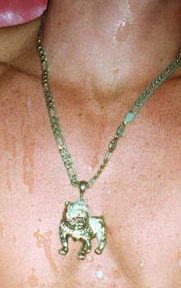 Lucus Cum from "Lost Boys" (Click for Full Monty) Mogutin is the author of two hardcover monographs of photography, Lost Boys and NYC Go-Go, and 7 books of writings published in Russian. He is the winner of the Andrei Belyi Prize for Literature (2000). His poetry, fiction, essays, and interviews have appeared in numerous publications and anthologies in 6 languages. He has translated into Russian Allen Ginsberg's poetry, William S. Burroughs' essays and Dennis Cooper's fiction. He appeared as an actor in Bruce LaBruce's agitprop porn movie Skin Flick (1999) and Laura Colella's independent feature Stay Until Tomorrow (2004). In 2004, together with his partner-collaborator Brian Kenny, he co-founded SUPERM, a multimedia art team responsible for site-specific gallery and museum shows in New York, Los Angeles, Moscow, Berlin, London, Oslo, Bergen, Haifa, and León, Spain.

1987 – Brendon Urie is an American singer, songwriter, and musician, best known as the lead vocalist of Panic! at the Disco, of which he is the only original member remaining. Urie was born in St. George, Utah, and his family moved to Las Vegas, Nevada, when he was two years old. He is of about one quarter Polynesian descent from Hawaii, through his mother's side. He was raised in an LDS family, but left the faith around 17 due to displeasure with the church and not believing in its ideology. Urie attended Palo Verde High School in Las Vegas, where he met future Panic! bassist Brent Wilson in his guitar class. Wilson asked Urie to try out for a band he was in, since they needed a replacement guitarist. Originally, Ryan Ross was their lead singer. When Urie filled in for Ross during a band rehearsal, they were impressed with Urie's vocal abilities and he was chosen as their lead singer. He officially joined the band in 2004. In high school, his friends chose him to be the band's lead singer after initially considering him for the guitarist position. Urie has appeared in albums, singles, musicals, a movie soundtrack, an award ceremony, and more. Many of his songs have achieved commercial success, reaching high spots on Billboard charts and millions of sales. Urie is known for his expansive four octave tenor vocal range. In 2018, he launched a non-profit organization for human rights and started streaming on Twitch. In 2013, Urie said that he had "experimented" with men but stated, "I guess if I had to classify myself, I'd say I'm straight." In July 2018, Urie described himself as pansexual and stated, "I'm married to a woman and I'm very much in love with her but I'm not opposed to a man because to me, I like a person. … If a person is great, then a person is great."
1993 – Carl Nassib is an American football defensive end who is a free agent. He played college football for the Penn State Nittany Lions, earning unanimous All-American honors as a senior in 2015. Nassib was drafted by the Cleveland Browns in the third round of the 2016 NFL Draft, and has also played for the Tampa Bay Buccaneers and Las Vegas Raiders. In 2021, Nassib became the first active NFL player to publicly come out as gay. He is also the first openly gay NFL player to play in a game. Nassib was born in West Chester, Pennsylvania. He attended Malvern Preparatory School, a Catholic private school in Malvern, where he was a three-year letterman in football. He played as an offensive tackle and defensive end. He helped lead the team to a 7–4 record in his junior and senior years. Nassib also lettered twice in basketball as well as three times in track and field. As a senior, he was selected team captain in basketball, helping lead the Friars to a 24–7 record. Nassib's father Gilbert Nassib played college football at the University of Delaware. His older brother Ryan was a quarterback at Syracuse University and played in the NFL from 2013 to 2017. On June 21, 2021, during Pride Month, Nassib released a statement on his Instagram account stating that he is gay, becoming the first active NFL player to come out publicly. In the statement, he pledged to donate $100,000 to The Trevor Project, an organization dedicated to crisis intervention and suicide prevention among LGBTQ youth, and to continue to champion their work. He received public support from the NFL, Raiders, Penn State, and current and former athletes. That day, jerseys and T-shirts with his name were the top sellers among all NFL players at Fanatics, the league's sales partner.
1994 – In response to a Hawaii Supreme court decision questioning the state's right to bar same sex marriage, the state senate passes a bill declaring that the need to "foster and protect the propagation of the human" is justification for the ban.
2010 – On this date the city council of Missoula, Montana voted 10-2 to approve of adding LGBT people to the city's employment and housing discrimination laws.
[{(o)}]|[{(o)}]|[{(o)}]|[{(o)}]| [{(o)}]|[{(o)}] |
